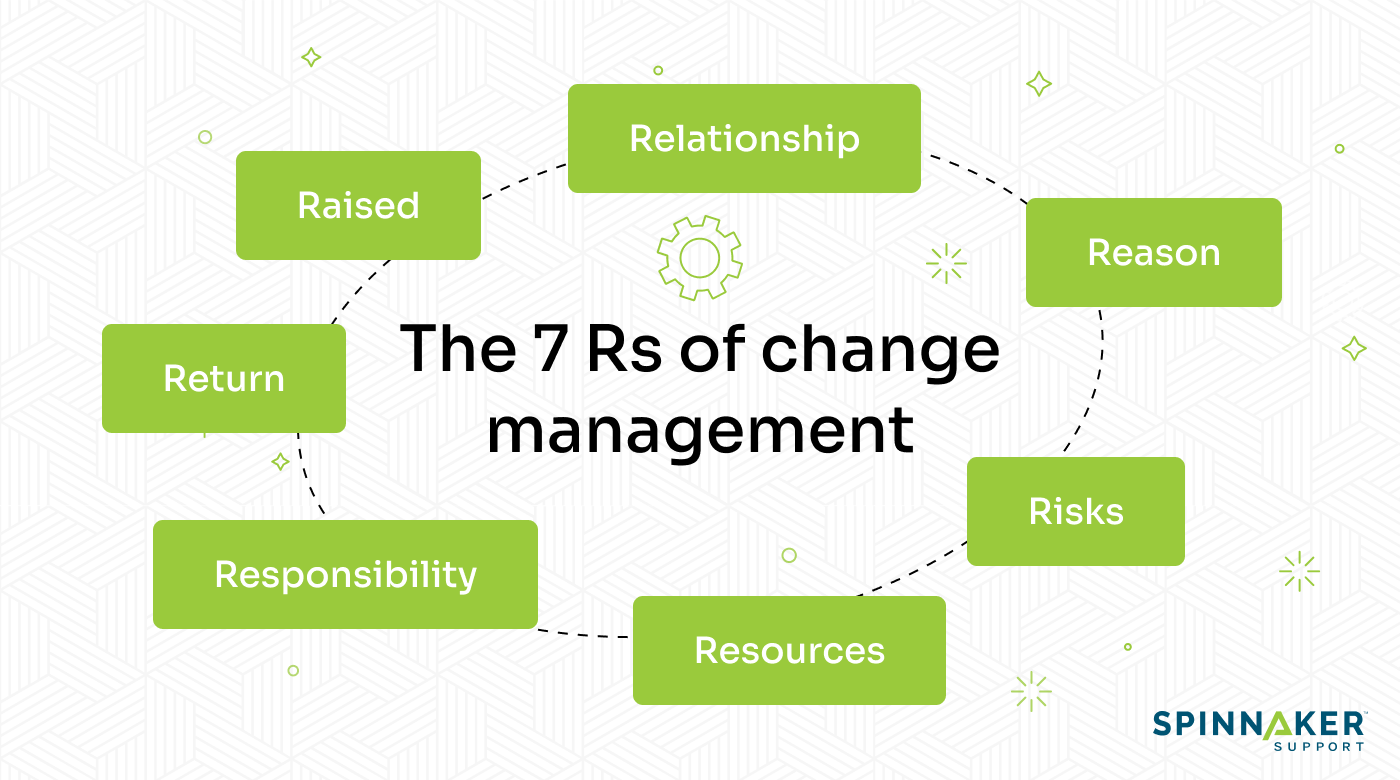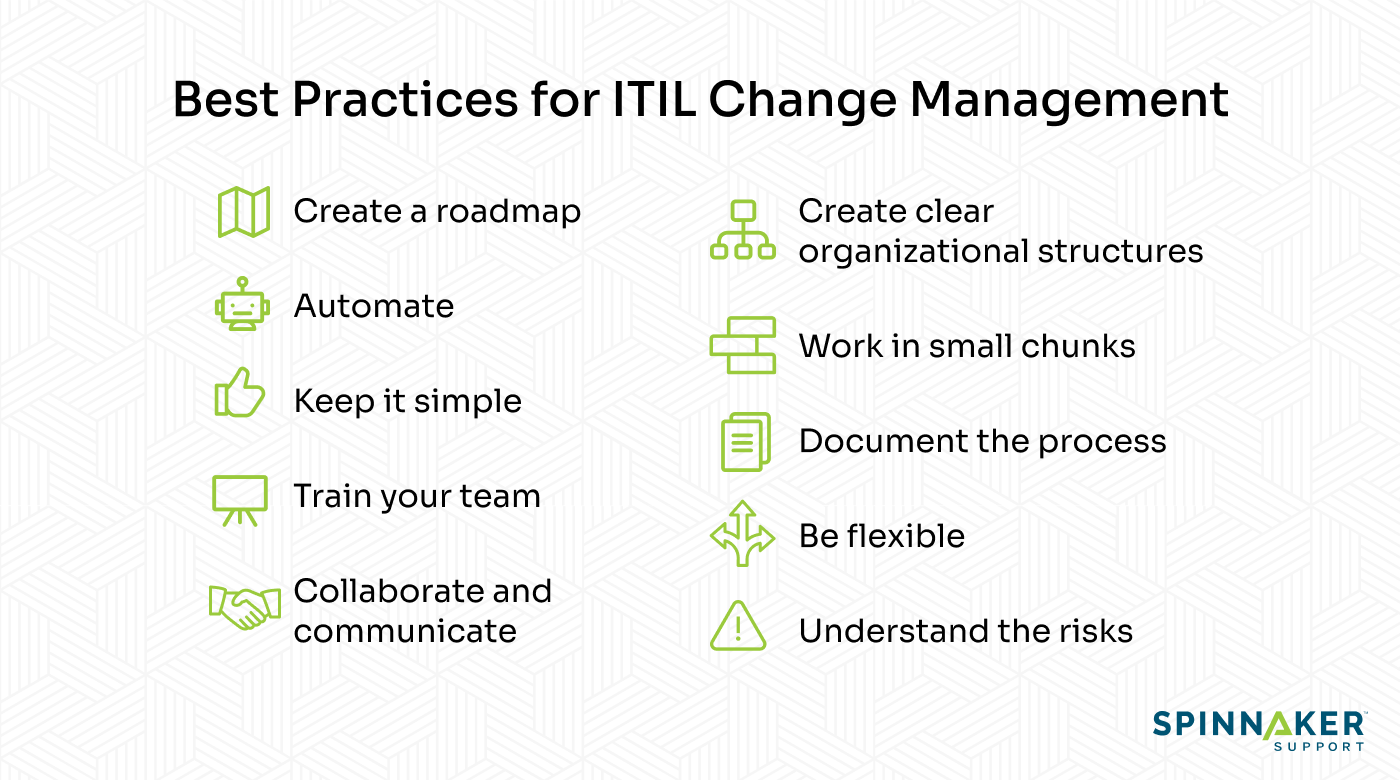
A Guide to ITIL Change Management
Businesses deal with changing requirements, whether they’re from their customers or for their internal processes, and addressing them effectively is key to their survival. However, just 34% of change initiatives are successful.
Considering the average company has implemented five major changes that have had a noticeable business impact within just the last three years, getting these initiatives right is the difference between going under and gaining a competitive edge.
Companies today rely more on their digital systems than ever before, and you can’t afford to overlook the IT infrastructure library (ITIL) framework. If you ever need to overhaul your approach to IT system management, the right change strategy should carry you to the finish line.
This article will walk you through what that looks like so you have everything you need to know about change management in ITIL, from the basics to best practices, along with actionable next steps.
What is change management in ITIL?
ITIL defines change management as modifying a company’s IT system. It tracks the entire process lifecycle, from ideation to post-implementation review, and its main aim is risk management.
Why is ITIL change management important?
Companies can’t afford to stay complacent. Change management helps companies adapt to changing markets and improve their bottomline.

Here are the benefits of ITIL change management.
1. Mitigates future risks
The ITIL change management process allows you to identify possible points of failure in your company and address them before they become serious issues. By implementing changes using this well-defined process, you also avoid the risks of unauthorized changes.
2. Helps scaling efforts
The ITIL framework is concerned with companies’ IT systems, and the change management process allows them to improve these systems as they scale. Modernized systems often result in higher operating capacities where they can do more and do it faster.
3. Adapts you to changing customer needs
The ITIL framework allows businesses to implement changes that let them work better for their customers so they can realize higher revenues. One of its main goals is to decrease the time spent processing user requests while increasing efficiency, directly impacting customer satisfaction.
4. Improves business processes
When evaluating your IT systems, you identify areas for improvement and target them during the change process. If you document these processes, you can draw insights that help you improve other areas of your business over time, including budgeting and project management.
5. Aids with cost management
When mapping your systems at the start of the change process, you can sniff out areas where you’re losing revenue and address them accordingly. Revamping your IT systems is as much about offloading excesses as replacing existing components with new ones.
6. Increases employee engagement and satisfaction
The ITIL change management process should involve the people it will affect, and if it’s done right, the team members involved come away better than they were when they went in.
We’ll cover this in more detail when going over best practices, but, in a nutshell, some of the benefits you can expect as far as your employees include increased morale, loyalty, and opportunities for career progression.
What are the types of change management in ITIL?
There are four types of change management in ITIL:
- Minor: This involves low-level modification to the IT infrastructure that is still subject to an approval process.
- Standard: Routine modifications, usually carried out on a regular schedule.
- Major: Refers to significant modification to the system that results in a complete overhaul of the infrastructure. It usually happens once every several years.
- Emergency: This involves an unscheduled process in response to recent major incidents or risks.
Spinnaker Support can help you figure out which type of change is right for your company.
What are the 7 Rs of change management in ITIL?

The 7 Rs of change management are the key points you’ll need to consider when initiating a formal request for change, and they are:
- Who Raised or suggested the change?
- What is the Reason for the change?
- What Return is required from the change?
- What are the Risks involved?
- What Resources are required?
- Whose Responsibility is it?
- What is the Relationship between this change and others?
When you’ve gone through this checklist and found that the change is necessary, you’ll need a solid set of best practices to guide the process.
What are the best practices for ITIL change management?
Successful change management requires a strategy that accounts for your company’s unique business requirements and every step from start to finish.

While the exact steps involved might differ between scenarios, here are Spinnaker Support’s proven ITIL change management best practices that should see you through the process.
1. Create a roadmap
Lay out your strategy with detailed information on what things look like at the start, why you’re implementing the change, and what success looks like. This is also where you’d define roles for your team members, as discussed in a later entry to this list.
Use the data you gathered when looking at the 7 Rs of change management to help you here. A solid roadmap will allow you to keep track of all the moving parts as the process moves along and prevent derailment.
2. Automate
If there’s any part of the process that you can automate, you should take the opportunity. Automation frees your team from repetitive and/or low-level tasks so you can direct more of your resources toward big-picture areas.
Some tasks you could automate include data collection, assigning tasks to team members, sending out reminders and daily status reports, and backups.
3. Keep it simple
Needlessly complicating things might end in your company spending more time and money on the change process than you’d set out to. Efficiency is a delicate balancing act, and working with a seasoned partner like Spinnaker Support is vital for distinguishing between working smart and cutting corners.
4. Prepare your team
Bring everyone on your team up to speed using the roadmap you created or even earlier in the process if possible. Clearly lay out the aspects of the business that the process will affect and how they should expect things to be at the end of it all.
Train them if necessary and fill in any knowledge gaps so you’re firing on all cylinders when you finally kick off the process.
5. Collaborate and communicate
About 52% of employees believe that collaboration in the workplace is an important component of success, and this sentiment holds true across all job levels.
With this in mind, you can use teamwork as an effective way to boost morale and bring everybody on board with the ITIL change management process. Maintain open lines of communication as well so nobody feels isolated, and your team members might become more involved.
6. Create clear organizational structures
Get everyone on the same page regarding their role in the process. As stated earlier when discussing the roadmap, having clear organizational structures where everyone knows where they fit, who they answer to, and who answers to them reduces conflicts and promotes accountability.
Look within your team for unique talents that you could leverage for the undertaking and encourage employees to come forward if they feel they’re qualified to take on specialized tasks. If you find people who are qualified enough, you can create an advisory board on which they sit.
Providing these kinds of opportunities for career growth and progression goes a long way toward raising morale.
7. Work in small chunks
Break up the process into manageable chunks that you can tackle more effectively. When you use this structure, you’re in a better position to give everything you work on more focus, and it’s easier to correct course if anything goes wrong.
Doing things this way applies the same basic principle behind sprints as used by DevOps teams, where the objective is to keep things fresh and prevent monotony. Spinnaker Support’s team of change management experts can help you determine how to break up the process in a way that makes sense for your scenario.
8. Document the process
Documentation allows you to continuously improve your processes by extracting insights from previous projects to identify your strengths and weaknesses.
With ITIL change management, you can retrospectively pinpoint things like bottlenecks and automatable tasks and gauge employees’ relevant skill levels. Use this information to build upon your processes for the next change or improve other areas of your business.
Documenting processes also makes debugging easier because you have a record you can use for future reference to trace your steps and/or recreate problems when troubleshooting.
9. Be flexible
These best practices are a useful guide, but they’re not set in stone, so avoid sticking to them rigidly. If you come up against something that seems to clash with an area of your business, discuss it with your advisory board or full team to find the best way forward rather than trying to retrofit your operations to work within these guidelines.
Spinnaker Support has a team of consultants that can work with you to find the most optimal routes to success. As stated at the start of this section, needs differ between companies, so it’s best to bend so you don’t break.
10. Understand the potential risks
You should set your ITIL change process up for success, but you should also prepare for the worst. It’s just the responsible thing to do. When you conduct a risk assessment, some dangers you face if the process fails include a ballooned budget, missed deadlines, and lack of support from relevant stakeholders.
Spinnaker Support’s change management specialists understand that acknowledging these risks is the only way to mitigate and completely avoid them. Some ways you do this include giving yourself some slack with the budget and not cutting it too close with deadlines.
What is the difference between ITIL V3 and V4 change management?
The biggest difference between ITIL V3 and V4 change management is the focus on practices over processes.
ITIL 4 introduced practices prioritizing a holistic approach built around adaptability and delivering value. Under V3, companies tended to rigidly stick to the processes, often to their own detriment. It’s the reason we recommend being flexible during the process because what works for you might not work for the next company.
Conclusion
Businesses average more than one major company-wide change a year, but most don’t pull these off successfully and can end up in a more vulnerable position. The ITIL framework lays out a set of practices that govern various areas of IT in business, including service management and change processes.
ITIL change management allows businesses to improve their processes, meet customer needs, and mitigate future risks. There are four types of change, denoted by scope and urgency: minor, standard, major, and emergency.
Some of the best practices when implementing ITIL change processes include creating a roadmap, automating wherever you can, involving your employees and stakeholders, and breaking up the process into smaller chunks.
Contact an ITIL change management specialist from Spinnaker Support to determine how you can shape up your IT system.



